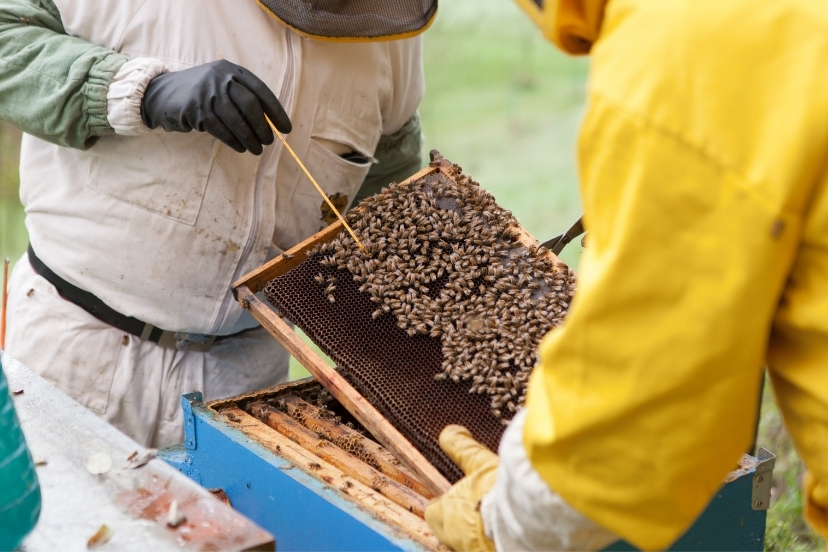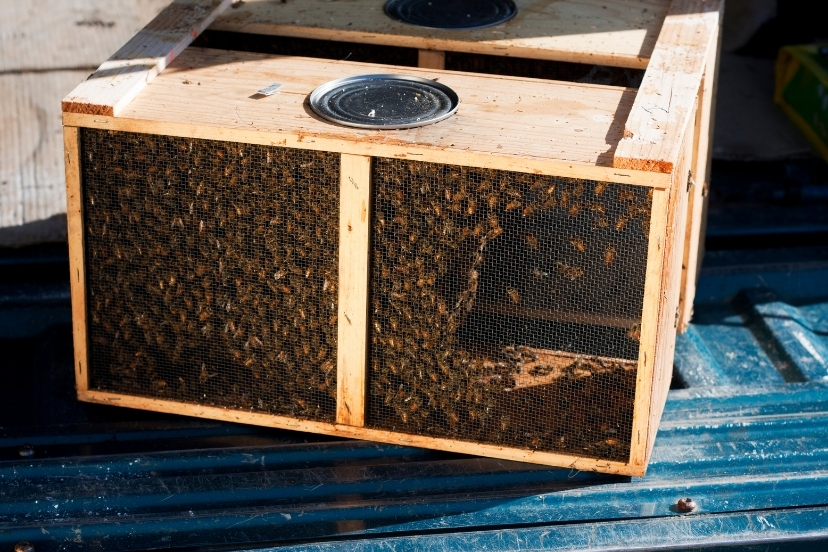Is urban beekeeping really possible? Can you really keep bees in the middle of a huge metropolis?
Yep, it is possible, and many people do it.
If you’re skeptical about the feasibility of keeping bees in the bustling city, would beehives kept on the roof of the Chicago City Hall convince you? It’s true.
Since 2000, Chicago has maintained hives on the City Hall rooftop.
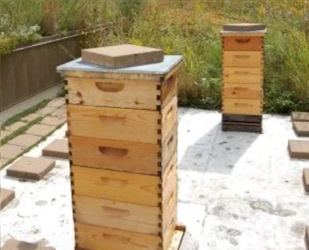
Recently, the City of Chicago has expanded their involvement in urban beekeeping by also placing bee hives on the roof of its Cultural Center.
So it is quite feasible to keep bees in an urban environment.
Urban Bee Can Thrive
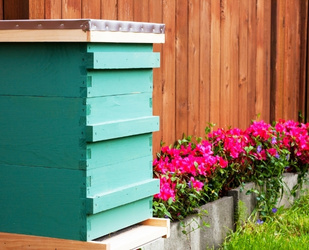
And it could even be argued that in some ways, city bees are better off than their country cousins. Bees kept in the country or even in a suburban environment are often at great risk of being poisoned by pesticides.
Whether encountered in a farm field sprayed by a crop duster, or in a homeowner’s back yard sprayed for dandelions, exposure to pesticides is devastating to honey bee colonies. But the risk of bees being exposed to a pesticide is much less in the middle of a city.
You might think that there wouldn’t be an adequate supply of nectar and pollen to support bee hives in a city, but that generally is not true.
Many Sources of Forage in Cities
A city environment actually offers multiple sources of forage for honeybees. A city park with flowering trees, clover growing in the grass of roadside medians, potted flowers on windowsills and balconies, and many other sources provide an abundance of bee forage.
In fact, there are professional beekeepers that keep their hives on city rooftops and balconies specifically to harvest and sell the honey.
How Do Bees Find Food In The City?
Want to Give it a Try? Make Sure it’s Legal
If you’re a city dweller, and you’re considering becoming involved in urban beekeeping, there are a few things to think about before ordering your hive. You need to make sure it’s legal in your city.
Mostly Encouraged
Most cities nowadays not only permit beekeeping, they even encourage it. But there are a few exceptions. One notable exception is the City of New York, which does not permit ownership of venomous insects.
However, there is an effort underway to change that law in New York. (In the meantime, there are a number of residents who keep bees on their rooftop anyway. Not that I’m encouraging anyone to violate the law, of course!)
(Update August 2010: New York beekeepers are no longer criminals. The city has lifted the ban on beekeeping. Hopefully other misguided city governments will soon follow NY’s example.)
Be Careful Where You Place Your Bees
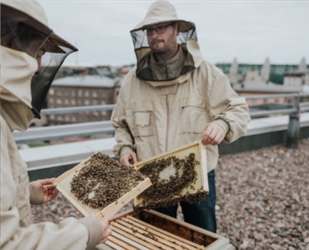
A rooftop or balcony will make an excellent location, but be sure that you have control over who has access to the hive.
You don’t want a neighbor’s child, for example, to have unsupervised access to the hive location.
And Exercise Sensible Precautions…
Take care to work your bees when conditions are good, and the bees likely to be gentle and non-aggressive (obviously a good idea no matter where you live!).
Also, be sure there are no pedestrians or bystanders around (other than those who have your permission to watch) when you work your bees. If the bees should become a bit testy, you don’t want anyone getting stung.
So if you’re interested in beekeeping, don’t let the fact that you live in a city keep you from giving it a try. Become an urban beekeeper.
I can’t think of a better way to connect with nature in the middle of the big bad city!
How To Get Started With Urban Beekeeping
Frequently Asked Questions
What are the benefits of urban beekeeping?
There are many benefits to urban beekeeping, including the following:
1. Increased local food production: Urban beekeeping can help to increase the amount of local food production, as bees play a vital role in pollination.
2. Improved air quality: Bees help to improve air quality by pollinating plants and flowers, which in turn produce oxygen.
What are the challenges of keeping bees in an urban environment?
There are several challenges to keeping bees in an urban environment. First, there is a lack of suitable forage for bees in many urban areas.
This can lead to bees becoming malnourished and stressed, which can in turn lead to a decline in the health of the hive. Second, urban areas are often more polluted than rural areas, which can also be detrimental to the health of bees.
How can I start beekeeping in my city?
There are a few things you need to do in order to start beekeeping in your city. First, you need to find a place to keep your bees. This can be a backyard, frontyard, or even a rooftop. Once you have a location, you need to purchase some beekeeping equipment. This includes a beehive, a bee suit, and some basic tools. You will also need to purchase some bees.
What are the best beekeeping practices for an urban environment?
There are a few things to consider when keeping bees in an urban environment. First, you need to make sure you have enough space for the hives. They need to be in a sunny spot that is protected from the wind. You also need to make sure the hives are not too close to any busy roads or areas where there are a lot of people.
Another thing to consider is what kind of bees you want to keep.
What are the most common problems that beekeepers face in an urban environment?
The most common problems that beekeepers face in an urban environment are:
1. Pests and diseases: Pests and diseases are a major problem for beekeepers in urban areas. There are many different types of pests and diseases that can affect bees, and it can be difficult to control them in an urban environment.
2. Lack of forage: One of the biggest problems for beekeepers in urban areas is the lack of forage for their bees.
How much time does beekeeping require?
Assuming you are talking about a hobby beekeeper with one or two hives, the amount of time required for beekeeping varies throughout the year.
In the spring, the bees are busy building up their populations and collecting pollen and nectar. The beekeeper may need to check the hives every few days to make sure the bees have enough room to store honey and to make sure the queen is laying eggs.
What can I do to help bees in my city?
There are a few things you can do to help bees in your city! One is to plant flowers that bees like to visit, such as lavender, clover, and daisies.
You can also make sure to not use pesticides in your garden, as they can be harmful to bees.
If you have a lot of land, you could even consider setting up a bee hotel or creating a wildflower meadow, which would provide a great habitat for bees.
What are the risks of beekeeping in an urban environment?
The risks of beekeeping in an urban environment are many and varied. They include the risk of being stung by bees, the risk of being attacked by bees, the risk of being allergic to bee stings, the risk of property damage, and the risk of personal injury.
What are the benefits of honey bees to the urban environment?
Honey bees are incredibly important to the urban environment for a number of reasons. First, they are responsible for pollinating a large percentage of the world’s crops, including many fruits and vegetables that are consumed by humans. Without honey bees, these crops would not be able to grow and produce food for people to eat.
Second, honey bees produce honey, which is a delicious and healthy food that can be used in a variety of ways.
How do bees fare in an urban environment?
Bees are important pollinators of both crops and wild plants, but their populations have been declining in recent years. A number of factors are thought to be responsible for this decline, including the use of pesticides, loss of habitat, and disease.
Urban environments can provide a good habitat for bees if they contain a variety of flowers that bloom at different times of the year.
How do beekeepers manage hives in an urban environment?
In an urban environment, beekeepers have to be extra careful to make sure their hives are not disturbed. Beekeepers in an urban environment typically place their hives on rooftops or in backyards. They also have to be careful to avoid pesticides and other chemicals that could be harmful to the bees.
How does the quality of honey produced in an urban environment compare to honey from rural areas?
The quality of honey produced in an urban environment is typically lower than honey from rural areas. This is because bees in urban areas are exposed to a greater variety of pollutants, including heavy metals and pesticides.
In addition, urban bees often have access to a less diverse range of pollen sources, which can impact the quality of the honey.

